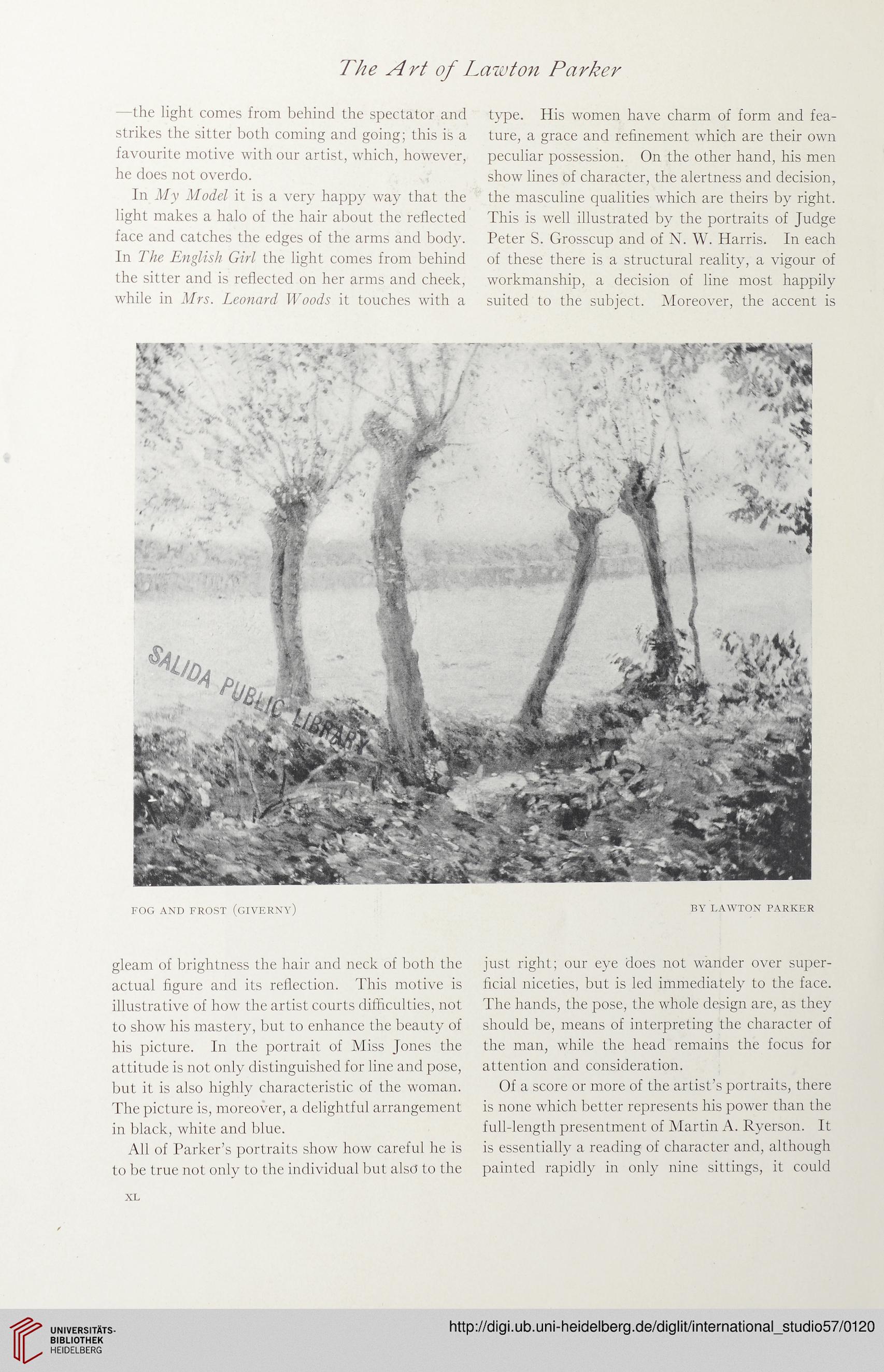The Art of Lawton Parker
—the light comes from behind the spectator and
strikes the sitter both coming and going; this is a
favourite motive with our artist, which, however,
he does not overdo.
In My Model it is a very happy way that the
light makes a halo of the hair about the reflected
face and catches the edges of the arms and body.
In The English Girl the light comes from behind
the sitter and is reflected on her arms and cheek,
while in Mrs. Leonard Woods it touches with a
type. His women have charm of form and fea-
ture, a grace and refinement which are their own
peculiar possession. On the other hand, his men
show lines of character, the alertness and decision,
the masculine qualities which are theirs by right.
This is well illustrated by the portraits of Judge
Peter S. Grosscup and of N. W. Harris. In each
of these there is a structural reality, a vigour of
workmanship, a decision of line most happily
suited to the subject. Moreover, the accent is
FOG AND FROST (GIVERNY)
BY LAWTON PARKER
gleam of brightness the hair and neck of both the
actual figure and its reflection. This motive is
illustrative of how the artist courts difficulties, not
to show his mastery, but to enhance the beauty of
his picture. In the portrait of Miss Jones the
attitude is not only distinguished for line and pose,
but it is also highly characteristic of the woman.
The picture is, moreover, a delightful arrangement
in black, white and blue.
All of Parker’s portraits show how careful he is
to be true not only to the individual but also to the
just right; our eye does not wander over super-
ficial niceties, but is led immediately to the face.
The hands, the pose, the whole design are, as they
should be, means of interpreting the character of
the man, while the head remains the focus for
attention and consideration.
Of a score or more of the artist’s portraits, there
is none which better represents his power than the
full-length presentment of Martin A. Ryerson. It
is essentially a reading of character and, although
painted rapidly in only nine sittings, it could
XL
—the light comes from behind the spectator and
strikes the sitter both coming and going; this is a
favourite motive with our artist, which, however,
he does not overdo.
In My Model it is a very happy way that the
light makes a halo of the hair about the reflected
face and catches the edges of the arms and body.
In The English Girl the light comes from behind
the sitter and is reflected on her arms and cheek,
while in Mrs. Leonard Woods it touches with a
type. His women have charm of form and fea-
ture, a grace and refinement which are their own
peculiar possession. On the other hand, his men
show lines of character, the alertness and decision,
the masculine qualities which are theirs by right.
This is well illustrated by the portraits of Judge
Peter S. Grosscup and of N. W. Harris. In each
of these there is a structural reality, a vigour of
workmanship, a decision of line most happily
suited to the subject. Moreover, the accent is
FOG AND FROST (GIVERNY)
BY LAWTON PARKER
gleam of brightness the hair and neck of both the
actual figure and its reflection. This motive is
illustrative of how the artist courts difficulties, not
to show his mastery, but to enhance the beauty of
his picture. In the portrait of Miss Jones the
attitude is not only distinguished for line and pose,
but it is also highly characteristic of the woman.
The picture is, moreover, a delightful arrangement
in black, white and blue.
All of Parker’s portraits show how careful he is
to be true not only to the individual but also to the
just right; our eye does not wander over super-
ficial niceties, but is led immediately to the face.
The hands, the pose, the whole design are, as they
should be, means of interpreting the character of
the man, while the head remains the focus for
attention and consideration.
Of a score or more of the artist’s portraits, there
is none which better represents his power than the
full-length presentment of Martin A. Ryerson. It
is essentially a reading of character and, although
painted rapidly in only nine sittings, it could
XL




